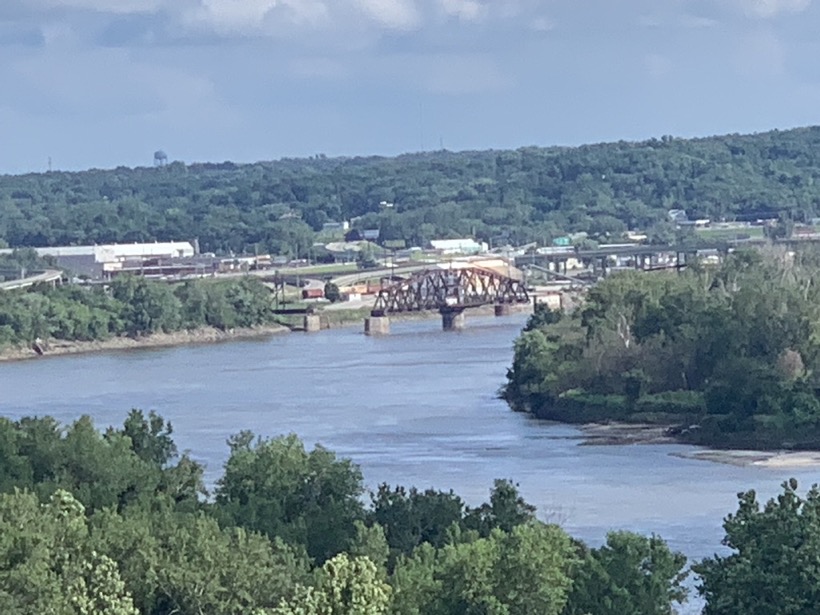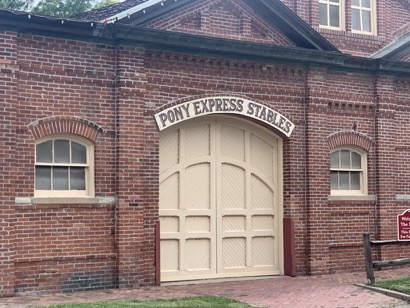St. Joseph
08/07/21 02:25

St. Joseph, Missouri looms large in the history that I studied as a student in elementary and high school. It was the starting point for many settlers who traveled west. Although Lewis and Clark and the Corps of Discovery officially started from St. Louis, some of the Missouri Basin had been explored. At St. Joseph the river turned northward and the adventure entered what was considered to be wild country. The railroad reached St. Joseph in 1859 and ferry service across the Missouri was established. St. Joseph became the provisioning point for settlers headed west on the California and Oregon trails. Those traveling on the Mormon trail also passed through St. Joseph and purchased needed supplies before heading out onto the prairies.
The settlers took the ferry across the river at St. Joseph and then headed west across what is now Kansas and Nebraska towards Wyoming. Many crossed the continental divide at South Pass in Wyoming. Those headed for California turned southwest across Utah and Nevada to California. Those headed for Oregon cut across Idaho and followed the Snake River towards the Columbia. There are many places throughout the west where you can still see the wagon ruts from the trail.
Traveling west was a huge adventure. Those with access to wagons could haul nearly a ton of food, supplies and household goods. Many attempted to bring too much and discarded items along the way. Departure on the trail was timed with the weather and the end of May was considered to be late for those who wanted to make the 2,000 mile journey before winter weather set in. The story of the Donner Party, caught in winter crossing the Sierra Mountains, was told as a cautionary trail about not starting on time and taking too long to make the journey.
We started this particular trip at our home in Mount Vernon, Washington, nearly as far northwest as you can get in the lower 48 states. We took some days to visit and rest in Big Timber Montana, but our actual travel to this point took us five days, traveling 300 to 400 miles each day. Travelers on the Oregon Trail averaged 15 to 20 miles per day with mules or oxen pulling the wagons. Many settlers walked most of the way, traveling alongside the animals and wagons. They needed days for rest and had to make repairs to wagons along the way. Three to four months was typical for the trip.

It was a relatively short, but very dramatic period in the story of the United States, when the country was engaged in expansion and settlement was driven by the discovery of gold and other precious metals in the west as well as the displacement of people by the Civil War.
Yesterday Susan and I reflected on a bit of that dramatic history of the mid nineteenth century as we took a walk along the Missouri River at St. Joseph. There is a nice paved walkway along the river that affords a great view of the river and an opportunity to think about the role of this area in the development of the lands where we have lived for almost all of our lives. For us the adventure has been in reverse from the settlers. We grew up and have lived in the west and the country east of the Missouri River is “foreign” to us. We’ve made several trips, but each time we are on a journey of discovery. The southeastern states are places where we have traveled infrequently and there is much for us to explore when we have the opportunity to take a trip like the adventure on which we are now embarked.
We also were reflecting on our personal journey as we walked yesterday. In the fall of 2019, as she was recovering from a nearly-fatal reaction to a drug administered in the hospital, Susan asked her electrophysiologist what she could do to regain her strength and keep her heart healthy. His response was to develop a discipline of exercise. 30 minutes of walking five days a week was suggested as a goal. We undertook that discipline and increased it slightly, walking seven days each week. These days we often walk more than 30 minutes and cover 2 to 3 miles each day in our formal walking. We have watches that record our walking and most days we have traveled between 5 and 8 miles at the end of the day. Figuring conservatively, we have walked more than a thousand miles since we adopted the discipline of daily walks. That isn’t quite the distance traveled by the settlers, many of whom walked 2,000 miles in four or five months, but a respectable bit of ground has passed under our feet in the past couple of years.
We, of course have some distinct advantages. For one thing we have good walking shoes that fit our feet well. We’ve worn the tread off of the bottom of shoes and have replaced them during our time of disciplined walking, but we’ve always had comfortable shoes. We take that for granted, as it is easy to obtain shoes that fit. This wasn’t the case for those who traveled the Oregon and California trials or for the Pony Express riders. Shoes that fit right and left feet were not available until after the Civil War and were uncommon for early travelers. A pair of shoes was two identical foot coverings that had to be worn to fit the foot.
Our journey continues - at a pace much quicker than the settlers. As we travel we remember their journeys.
